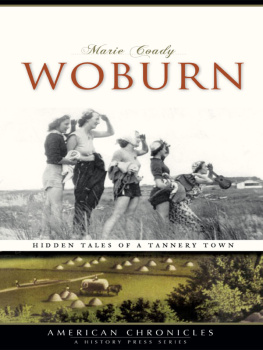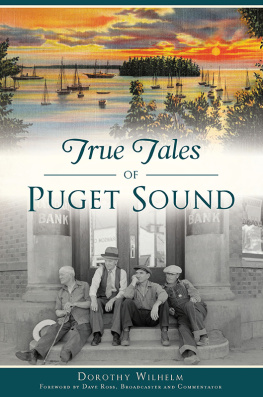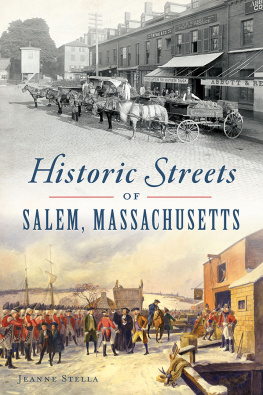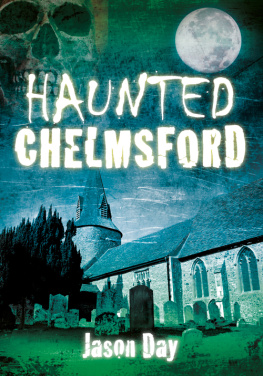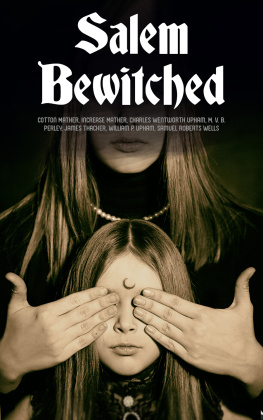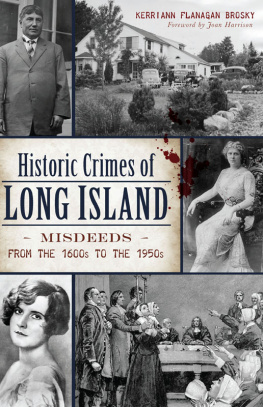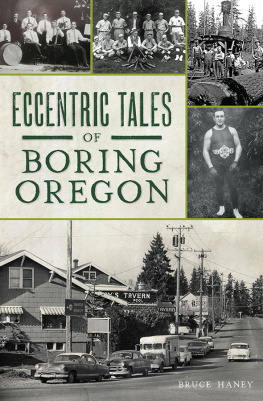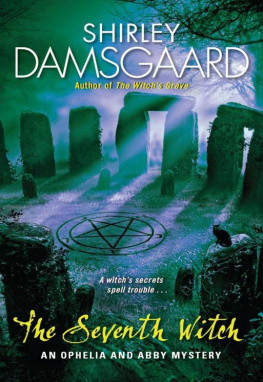

Published by The History Press
Charleston, SC 29403
www.historypress.net
Copyright 2008 by Marie Coady
All rights reserved
Cover design by Natasha Momberger
First published 2008
e-book edition 2013
ISBN 978.1.62584.878.9
Library of Congress Cataloging-in-Publication Data
Coady, Marie.
Woburn : hidden tales of a tannery town / Marie Coady
p. cm.
print edition ISBN 978-1-59629-514-8
1. Woburn (Mass.)--History--Anecdotes 2. Woburn (Mass.)--Social life and customs--Anecdotes 3. Tanneries--Massachusetts--Woburn--History--Anecdotes 4. Historic sites--Massachusetts--Woburn--Anecdotes 5. Woburn (Mass.)--Biography--Anecdotes 6. Coady, Marie. I. Title.
F74.W89C63 2008
974.44--dc22
2008027632
Notice: The information in this book is true and complete to the best of our knowledge. It is offered without guarantee on the part of the author or The History Press. The author and The History Press disclaim all liability in connection with the use of this book.
All rights reserved. No part of this book may be reproduced or transmitted in any form whatsoever without prior written permission from the publisher except in the case of brief quotations embodied in critical articles and reviews.
CONTENTS
PREFACE
If you were not born and raised in the city of Woburn, the natives good-naturedly label you a Carpetbagger, and thats pretty much what I am. Although, in the spirit of reconciliation, one of Woburns more progressive mayors presented me with a proclamation announcing that the governing body of the City of Woburn has been petitioned to elevate Marie Coady to the august status of native Woburnite, thereby eliminating her previous lower rank as Carpetbagger. So, as an official Woburnite, I was then allowed to set forth to catalog the hidden stories in Woburns history.
Actually, my interest in Woburn history was spurred on long before I became an official Woburnite. Having been born and raised in a house along the red line of the Freedom Trail and in the shadow of the Bunker Hill Monument in the Charlestown section of Boston, I couldnt help but be interested in the history that surrounded me.
Then, in 1993, while researching the Revolutionary soldier whose gravestone lay under my bedroom window in Charlestown, I found a Woburn connection. Thats when I realized that Woburn is the quintessential community with six degrees of separation to people and places all over the world. Moreover, all of the stories Ive uncovered prove beyond the shadow of a doubt that history does indeed repeat itself.
The opening chapters cover the uniqueness of the name that the founders chose for the then town of Woburn in 1642, and the subsequent chapters follow that uniqueness into the present day.
Because Woburn has two very historic and well-cared-for burial grounds, aptly enough named the First Burial Ground and the Second Burial Ground, and when I leaned that it had been almost 150 years since an inventory of both burial grounds had been done, I decided to take on the challenge. With the encouragement of a friend in Winston, Georgia, who had strong ancestral connections to Woburn, I formed what became known as the Grave Group. With cameras in hand, the Grave Group set out to do a pictorial inventory of both burial grounds. All of our work was then posted on Toni Lasseters Ye Olde Woburn website (http://www.yeoldewoburn.net).
Since roaming through graveyards oftentimes unearths skeletons, the Grave Group managed to uncover some of the really unique stories that I have catalogued in the subsequent chapters. That experience got me hooked and I kept looking in other places for skeletons in Woburns closet, and found many. One of the most interesting stories I uncovered was Woburns connection to the Boston Massacre, which I detail in a chapter of that title.
Because Woburn is a next-door neighbor to the town of Lexington, where the Battles of Lexington and Concord took place, Woburns part in that battle often gets short shrift. With that in mind, I relate some of the events that mark Woburns part in that famous battle in a chapter entitled Restoring Battle Roads Human History. I would be remiss if I wrote anything about Woburn without at least mentioning its most illustrious family, the Baldwins. Toward that end, I catalogue the connection between Loammi Baldwin II and the Bunker Hill Monument.
Being a longtime member of the Woburn Historical Commission and being tasked with protecting Woburns historic homes and landmarks has given me an opportunity to research the history of many historic houses in the city. One of the most unique and well-cared-for of those houses is the 1790 House. It was through my research into the social history of that elegant house that I came to know Eunice Carter Thompson, and I share her story in a chapter entitled Born in the 1970 House. I think you will find it compelling.
There are also the tragic stories of murder and mayhem as well as the loss of five members of the same family to the deep, dark waters of Woburns Horn Pond. Woburn also has its urban legends and I reveal one of the more interesting ones here for you to enjoy. Other chapters cover the darker stories that have left a legacy of Superfund sites and wells that poisoned many children. Its a battle that continues to this day.
Then there are the stories that inspire, one of which is entitled Walnut Hill and the Great Depression, circa 1936. This story tells how a community came together to save a desperately poor widow from abject poverty during the Depression. Another story, Woburns Ya-Ya Sisterhood, will fill you with delight as it tells of a lifetime of friendships that not only stood the test of time but distance. There are also the stories that prove that the more things change the more they stay the same, including Same-Sex Marriage, circa 1878; Suicidal Parrots and Gypsy Royalty; Woburns Ovaltine Connection; and If Walls Could Talk.
Most of the hidden stories I tell in this book were uncovered by poring through old newspapers, and my research disproves the old saying that yesterdays newspaper is only good for lining the birdcage. Thats where the hidden history of a community can be found, reincarnated and enhanced by implementing todays research tools.
I would be remiss if I didnt mention the many people who helped in making this book come alive, namely the people who shared their photo collections and skills toward that end. A special thanks to fellow historians John McElhiney and Tom Smith for sharing their wonderful historic photos from their very unique collections, and also to Bud Fowle for sharing photos from his familys collection. Since I am a writer and not a photographer, my very special gratitude goes to Gerry Kehoe of Innitou Photo for sharing her photographic skills. Gerry made special trips to the First and Second Burial Grounds to capture the unique inscriptions on gravestones there that tell the most interesting stories. Many of the other photos were shared with me by the people who also shared their family stories and they are duly noted in the image credits.
As my proclamation declaring me no longer a Carpetbagger concluded: Marie Coady shall be known to all natives of North, South, East and West Woburn, as well as Mount Misery, Central Square and Rag Rock as NATIVE WOBURN CITIZEN MARIE COADY, thereby eliminating all her whining about her previous Carpetbagger status. And for that I am grateful. I am also grateful to Mayor Robert Dever for making me feel at home here in Woburn and for helping me to stop whining.
Next page
